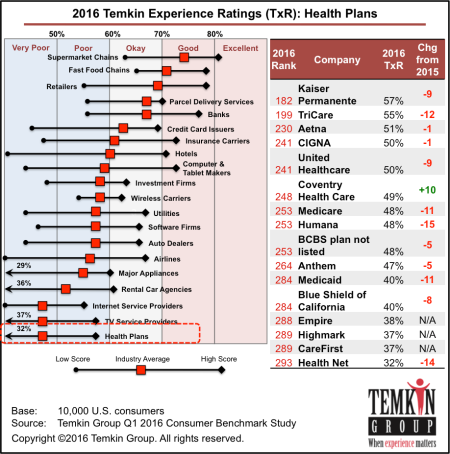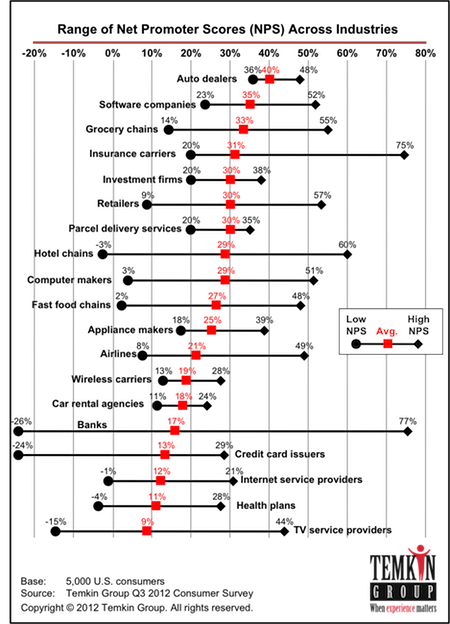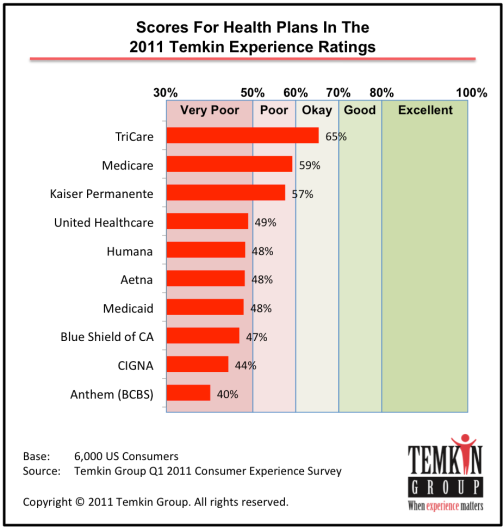Temkin Group has just released the 2012
 We introduced the Temkin Web Experience Ratings last year. The 2012 Web Experience Ratings include 159 companies from 18 industries and is based on a survey of 10,000 U.S. consumers.
We introduced the Temkin Web Experience Ratings last year. The 2012 Web Experience Ratings include 159 companies from 18 industries and is based on a survey of 10,000 U.S. consumers.
Congratulations to the top firms in this year’s ratings: Amazon, credit unions, USAA, PNC, Southwest Airlines, eBay, Sam’s Club, ShopRite, JCPenney, and ING Direct. Of course, not every company has earned good web experience, especially the companies at the bottom of the 2012 ratings: Charter Communications, Humana, Qwest, Cigna, Time Warner Cable, Anthem, Road Runner, Medicare, Blue Shield of CA, and TracFone.
 We also examined industry averages and found that banks and investment firms have earned the highest Temkin Web Experience Ratings followed by hotel chains and retailers. But consumers gave very low ratings to Internet service providers, health plans, and TV service providers.
We also examined industry averages and found that banks and investment firms have earned the highest Temkin Web Experience Ratings followed by hotel chains and retailers. But consumers gave very low ratings to Internet service providers, health plans, and TV service providers.
 The research also examines how individual companies are rated relative to their industry peers. The following 11 firms outscored their industry average Temkin Web Experience Ratings by 10 percentage points or more: Kaiser Permanente, Amazon, ShopRite, Southwest Airlines, USAA, Starbucks, H.E.B., Publix, credit unions, Marriott, and Apple.
The research also examines how individual companies are rated relative to their industry peers. The following 11 firms outscored their industry average Temkin Web Experience Ratings by 10 percentage points or more: Kaiser Permanente, Amazon, ShopRite, Southwest Airlines, USAA, Starbucks, H.E.B., Publix, credit unions, Marriott, and Apple.
The following 15 companies fell 10 percentage points or more below their industry averages: Wells Fargo Advisors, AAA, Charter Communications, Delta Airlines, Citibank, Bank of America, Humana, TracFone, Qwest, Old Navy, U.S. Airways, Rite Aid, Kohl’s, Kmart, and Charter Communications.
Temkin Group also analyzed changes from the 2011 Temkin Web Experience Ratings. Led by TV service providers and insurance carriers 11 of the 12 industries that were in both the 2011 and 2012 ratings improved since last year.
 Seventy-two percent of companies that were in the 2011 and 2012 Temkin Web Experience Ratings showed improvement. Led by Comcast (Internet and TV service), Allstate, AOL, Charter Communications, Toshiba, and Sam’s Club, 20 companies improved by 10 percentage points or more between 2011 and 2012. Only three companies— Kohl’s, TracFone, and Rite Aid—declined by 10 percentage points or more during that timeframe.
Seventy-two percent of companies that were in the 2011 and 2012 Temkin Web Experience Ratings showed improvement. Led by Comcast (Internet and TV service), Allstate, AOL, Charter Communications, Toshiba, and Sam’s Club, 20 companies improved by 10 percentage points or more between 2011 and 2012. Only three companies— Kohl’s, TracFone, and Rite Aid—declined by 10 percentage points or more during that timeframe.

 Do you want to see the data? Go to the Temkin Ratings website where you can sort through all of the results for free. You can even purchase the underlying data if you want to get more access.
Do you want to see the data? Go to the Temkin Ratings website where you can sort through all of the results for free. You can even purchase the underlying data if you want to get more access.
The bottom line: Web experience is not good enough for how important it is
Filed under 2012 Temkin Ratings, Customer experience, Online strategy
Tagged with AAA, Acer, Aetna, Albertsons, Aldi, Allstate, Amazon.com, American Airlines, American Express, Anthem (BCBS), AOL, Apple, AT&T, Bank Of America, Barnes & Noble, Best Buy, Best Western, Blue Shield of California, Bright House, Budget, Cablevision, Capital One, Charles Schwab, Charter Communications, Chase, Chevrolet, Cigna, Citibank, Citigroup, Comcast, Comfort Inn, Compaq, Continental Airlines, Costco, Cox Communication, Cox Communications, credit unions, CVS, Dell, Delta/Northwest Airlines, DirecTV, Discover, DISH Network/EchoStar, E*Trade, eBay, eMachines, Enterprise, Farmers, FedEx, Fidelity Investments, Food Lion, Ford, Gateway, GE, Geico, Giant Eagle, H.E.B, Hampton Inn, Hertz, Hewlett-Packard, Hilton, Holiday Inn, Holiday Inn Express, Home Depot, Honda, HSBC, Humana, ING Direct, JCPenney, JetBlue Airlines, Kaiser Permanente, Kmart, Kohl's, Kroger, LG, Liberty Mutual, Lowe's, Macy's, Marriott, Medicaid, Medicare, Merrill Lynch, MSN, Nationwide, Nissan, Old Navy, Optimum (iO)/Cablevision, PNC, Progressive, Publix, Qwest, Rite Aid, Road Runner, Safeway, Sam's Club, Samsung, Save-a-Lot, Sears, ShopRIte, Sony, Southwest Airlines, Sprint, State Farm, Stop & Shop, T-Mobile, Target, TD Ameritrade, Time Warner Cable, Toshiba, Toyota, TracFone, TriCare, U.S. Airways, U.S. Bancorp, U.S. Bank, U.S. Postal Service, United Airlines, United Healthcare, UPS, USAA, Vanguard, Verizon, Verizon Wireless, Virgin Mobile, Wal-Mart, Walgreens, Wells Fargo, Wells Fargo Advisors, Wells Fargo/ Wachovia Bank, Whirlpool, Whole Foods, Winn-Dixie
 We recently released the 2017 Temkin Experience Ratings that ranks the customer experience of 331 companies across 20 industries based on a survey of 10,000 U.S. consumers.
We recently released the 2017 Temkin Experience Ratings that ranks the customer experience of 331 companies across 20 industries based on a survey of 10,000 U.S. consumers.



































